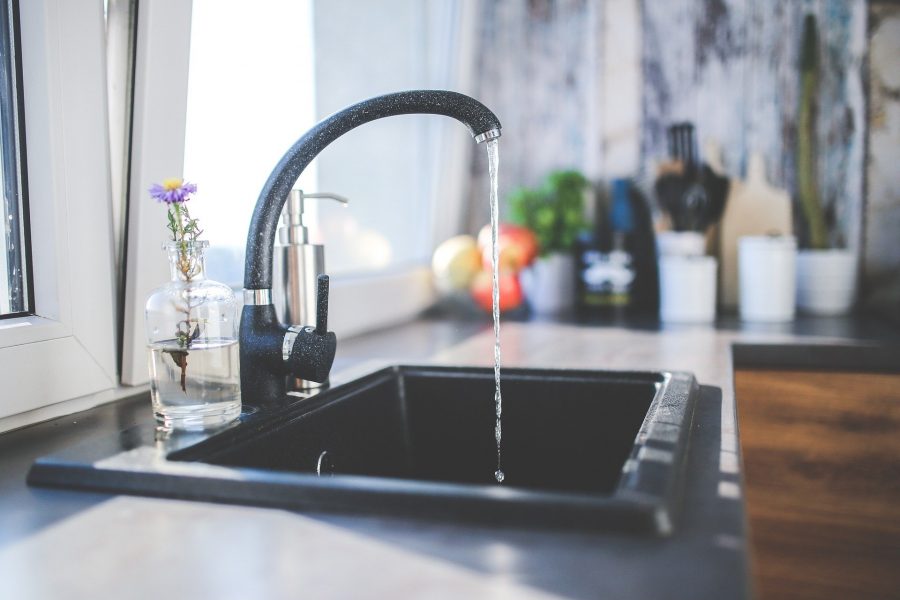The Surprising Contaminants In Tap Water And What You Can Do
By Liane Moccia, Herbalist
Most of us don’t think about the water we drink. We are fortunate to live in a country with abundant, safe water. We know water is essential for good health and try to drink at least 8 glasses per day. But what if our water isn’t as pure as we think? If you are drinking water straight out of the tap, it may contain more contaminants than you may know.
As a clinical herbalist who specializes in fertility and pregnancy planning, the impact of toxins in our water is something I take very seriously. Every day, I encourage the women I work with to drink plenty of water and herbal teas as part of a healthy preconception protocol. But if that water is contaminated with environmental toxins, then the overall health and wellness of my clients and their babies could be affected. And, unfortunately, contamination is more common than most of us may think. This is what inspired me to research water filtration options for my clients and my own family.
In the last few years, scandals like lead contamination of the drinking water in Flint, MI, has brought the safety of our water into the spotlight. But many people wrongly believe that Flint was an isolated issue that couldn’t happen again today. And when it comes to contaminants in our water, it’s more than just lead.
What kind of toxins could be in our water? Contaminants from industrial dumping (legal or illegal), agricultural pesticides, intentionally added disinfection chemicals, along with dozens and dozens of pharmaceuticals that are showing up in our water.
Some of the following statistics may be surprising:
- 77 million Americans drink tap water that has violated the Safe Drinking Water Act because of excess contamination1. That's nearly 1 in 4 people drinking contaminated water in the US!
- 5,300 US water systems are in violation of lead rules2, including failure to properly test water for lead, failure to report contamination to residents, and failure to treat water properly to avoid lead contamination.
- In 2017, an NPR investigation reported more than 3,000 cases around the U.S. where lead levels were double that of Flint, MI3. Lead is a potent neurotoxin that impairs children’s intellectual development and alters their behavior and ability to concentrate. The impacts of lead exposure during childhood are permanent. There is a strong scientific consensus that any amount of lead exposure during childhood is harmful. In adults, lead exposure can weaken kidney function and increase the risk of kidney related diseases and can exacerbate diseases like dementia and Alzheimer’s.
- Almost 90% of drinking water sampled by the USDA had traces of atrazine, the most widely used herbicide in the US. Research by the Environmental Working Group (EWG) shows that atrazine is the most commonly detected pesticide in tap water, often at concentrations that can be higher than what the federal law allows 4. It is also found in well water since it leaches into the groundwater and then into your well water. Atrazine is a hormone disrupting chemical linked to increased risk of miscarriage, birth defects, poor sperm quality, menstrual problems, and elevated risk of breast and prostate cancer.
- According to an EWG investigation, roughly 85% of the population was drinking tap water that contained over 300 contaminants—more than half of which were not regulated by the EPA.
- The Centers for Disease Control and Prevention (CDC) is now calling contaminated drinking water "one of the most seminal public health challenges of the coming decades5."
These are just a few of the contaminants that can be found in our drinking water. Long term, low-level consumption of these contaminants and others can affect our health. They have been associated with chronic health issues like cancer, diabetes, heart disease, infertility, obesity, digestive problems, autoimmune disorders, and skin problems.
But there are easy steps we can take to improve the quality of the water we drink every day in our homes!
Before we jump into water filtration options, a question that often comes up at this point is “what about bottled water”? Is it safer and easier to just drink bottled water?
Surprisingly, most bottled water doesn’t come from the clear springs that they are named after. A 2009 study by Food & Water Watch found 50% of all bottled water was taken directly from the local municipal tap water6.
Another problem with bottled water is the plastic bottle. The type of plastic that most single use bottles of water are made of is PET (polyethylene terephthalate). A number of studies have shown that PET plastic water bottles leach estrogenic chemicals into the water7. In addition to the potential exposures to synthetic estrogens in plastic water bottles, we cannot ignore the tremendous waste they create for the environment.
For daily consumption, bottled water is not the answer. It’s expensive, potentially leaches more chemicals into the water, and is polluting the environment.
The answer to safe, clean water is to filter! But what filter is the best?
The official answer to this question is “it depends”. It depends on the water quality in your town, if you own or rent your home, and how much money you want to spend. The Environmental Working Group’s Tap Water Database is a great place to start. Searchable by zip code, you can access the water reports for your town so you know what contaminants are typically found in your municipal water. You can also test your own water. Tap Score offers simple and easy mail service for testing. They have general tests for city water and well water, and also offer specialized testing for things like heavy metals, glyphosate, pharmaceuticals, radioactives, bacteria, and even PFAS chemicals.
Once you know what’s in your water, you are ready to select a filter.
The easiest way to start filtering your water is to get a countertop filter. Pitchers can filter out most contaminants and come in BPA free containers. I wish they were available in glass, but for now, this is the best we have. Pay attention to the list of contaminants that the pitcher is verified to remove, not just the marketing claims. The EWG has some basic guidelines at Water Filter Guide to help you find the right filter for you water and budget. I used the old EWG database when deciding what filter to use for my home and was surprised by the results. For example, Britta and Pur are the two most popular countertop carbon filter pitchers. They actually filter fewer amount of contaminants, filtering only a couple specific industrial pollutants. Their standard countertop pitchers don’t filter lead or fluoride (but they do both offer an upgraded filter that includes lead). In our home, we use Clearly Filtered.*
You could also consider an under the sink filtration system. These cost more but are more convenient (no need to refill a pitcher), no pitcher to clutter the counter, and you have access to filtered water by just turning on your tap.
Whole house filters are also an option, but they can cost thousands of dollars and may not be necessary for your situation. You also can’t take it with you if you move.
Lastly, consider filtering your shower water as well. Chlorine is present in all tap water to disinfect and keep the water free of pathogenic bacteria. A countertop or undersink filter will remove chlorine, but what about in your shower or bath? Chlorine is a volatile chemical, so it quickly and easily vaporizes. In a hot shower situation, we end up inhaling and absorbing chlorine through our skin in amounts that can exceed what we get from drinking chlorinated water.
Because our skin has its own delicate microbiome, showering or bathing in chlorinated water can exacerbate skin issues like eczema. Chlorine is also a respiratory irritant that can cause or worsen asthma, and overall can cause eye and throat irritation. This is even more important when you are pregnant and after the baby is born when baths are part of the daily routine.Water filtration is a simple way to reduce your exposure to potentially harmful contaminants and support your overall health. Resist feeling overwhelmed or getting stuck making decisions by taking action today. Follow the guidelines covered in this article and choose what feels best for you at this point in your life! You can always make changes down the road.
This one step will have a huge ripple effect for your health, and the health of everyone in your home. Think of how often you drink water, tea, or coffee… and how many times you shower or bathe. If you have little ones in your home, you may need water for formula, drinking water, and so many baths! This one investment in health will continue to pay off for years to come.
Liane Moccia is a Certified Herbalist who specializes in fertility, preconception planning, hormone balance, stress and sleep. She is a graduate of the Wintergreen Botanical’s full herbalist training program and is currently one of Maria’s Education Advisors. Liane has a clinical practice in Massachusetts with the capability to see clients virtually. She is the creator of the Pre-Pregnancy Detox Program: A 14-Day program to reset and renew. You can learn more about Liane and download the 5 Simple Changes to Improve Your Fertility Today guide on her website, www.lianemoccia.com .
The statements made on this blog have not been evaluated by the FDA and are not intended to diagnose, prescribe, recommend, treat, cure, or offer medical advice. Please see your health care practitioner for help regarding choices and to avoid herb-drug interactions.
Neither Liane Moccia/Liane's Herbal Wellness nor Maria Noel Groves/Wintergreen Botanicals are affiliated with the companies mentioned in this article. We have no ties and and have purposely not included any affiliate links within this article. Liane uses Clearly Filtered in her home on public water supply. Maria uses the Brita top faucet filter because it meets her need for convenience, filtration for her well water, and price (she hates dealing with pitchers and can't afford an under-the-sink nor whole house option) even though it doesn't filter as many contaminants. These are our personal decisions based on preference and needs. Hopefully with the resources in this article you can do your own digging to find the option that works best for you.
References:
1 NRDC. “Threats on Tap: Widespread Violations Highlight Need for Investment in Water Infrastructure and Protections.” Web 2017. https://www.nrdc.org/resources/threats-tap-widespread-violations-water-infrastructure
2CNN. “5,300 U.S. Water Systems Are In Violation of Lead Rules.” Web 2016.https://www.cnn.com/2016/06/28/us/epa-lead-in-u-s-water-systems/index.html
3 WBUR - Boston. NPR Morning Edition. "Lead In Our Water: The National Picture." Web
May 2, 2017. https://www.wbur.org/morningedition/2017/05/02/may-02-2017-me
4 EWG. “EWG’s Tap Water Database Atrazine.” Web 2019. https://www.ewg.org/tapwater/reviewed-atrazine.php#:~:text=EWG%20research%20shows%20that%20atrazine,to%20corn%20and%20soybean%20fields.
5 Bloomberg Law. “CDC Sounds Alarm on Chemical Contamination in Drinking Water.” Web 2017. https://news.bloomberglaw.com/environment-and-energy/cdc-sounds-alarm-on-chemical-contamination-in-drinking-water
6 Food and Water Watch. “Tap Water vs. Bottled Water”. Web 2021 https://www.foodandwaterwatch.org/about/live-healthy/tap-water-vs-bottled-water
7 Sax, Leonard. "Polyethylene terephthalate may yield endocrine disruptors." Environmental Health Perspectives 118.4 (2010): 445.
* This comparison is based on an older form of the EWG guide that used to compare each brand filter and what they filtered out. This level of detail is unfortunately no longer available on the EWG guide. You can see similar information on this chart comparing Pur to Britta (showing Pur filters 2x more contaminants) and they reference specific models: https://www.pur.com/why-pur/filter-comparison Britta publishes this list of certified contaminants that it can filter, and it correlates to what Pur shows on their website: https://www.brita.com/wp-content/uploads/LL-Final-PDS-120920_w-color2.pdf Then, you can compare the contaminant filter chart on Clearly Filtered website which lists the contaminants they are certified to remove. The list is longer than Pur: https://www.clearlyfiltered.com/pages/performance-data-for-the-clearly-filtered-water-pitcher-and-filter
Photo Credit: Tap Water Image by Karolina Grabowska from Pixabay


